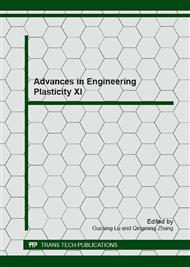p.189
p.193
p.197
p.201
p.205
p.211
p.215
p.219
p.223
Propagation Behavior of Main Crack in Reinforced Concrete Beams Strengthened with CFRP under Cyclic Bending Load
Abstract:
Fatigue behavior of reinforced concrete (RC) beam can be improved by externally bonded fiber reinforced polymer (FRP). However, propagation behavior of a crack on the RC beam will have serious effect on the fatigue life of the beam strengthened with FRP. In this paper, a finite element (FE) procedure was developed to analysis the stress intensity factor (SIF) of the main crack and an experimental study was conducted to investigate the propagation rate of the main crack of the RC beam strengthened with carbon fiber laminate (CFL) under cyclic bending load. The FE analysis results show that the SIF near the main crack tip increases at the beginning and then decreases with the fatigue crack propagation. When relative crack length α is equal to 0.3, the SIF is maximum. When α approaches 0.75, the SIF approaches zero. A total of 3 RC beams strengthened with CFL were tested. The experimental results show that it is possible to divide the process of the crack propagation into three distinct phases, including crack initiation and then quickly propagation, stable propagation and then rest and unstable propagation. A semi-empirical equation based on the Paris Law was developed to predict the crack propagation rate.
Info:
Periodical:
Pages:
205-208
Citation:
Online since:
January 2013
Authors:
Price:
Сopyright:
© 2013 Trans Tech Publications Ltd. All Rights Reserved
Share:
Citation:


